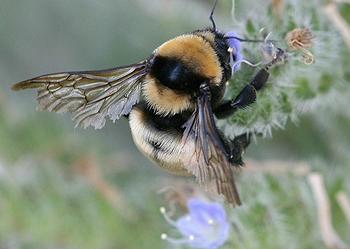Extinction Threatens One-Quarter of Europe’s Bumblebees
GLAND, Switzerland, April 3, 2014 (ENS) – Seventeen of the 68 species of European bumblebees are threatened with extinction, finds a new study assessing the species group at the European level.
“We are very concerned with these findings. Such a high proportion of threatened bumblebees can have serious implications for our food production,” said study coordinator Ana Nieto, European biodiversity officer with the International Union for the Conservation of Nature, IUCN, which maintains the Red List of Threatened Species.
Bumblebees, like other pollinators, allow plants to reproduce and improve the production of crops, such as tomatoes, peppers and many other types of fruit, vegetables and seeds.

Europe’s largest bumblebee Bombus fragans, Cappadocia July 2009 (Photo by Hulterstad)
Of the five most important pollinators of European crops, three are bumblebee species. Together with other pollinators, bumblebees contribute more than 22 billion euros to European agriculture per year.
“Protecting bumblebee species and habitats, restoring degraded ecosystems and promoting biodiversity-friendly agricultural practices will be essential to reverse the negative trends in European bumblebee populations,” said Nieto, releasing the study’s findings on Wednesday.
The European Commission-funded study is part of the Status and Trends of European Pollinators, STEP, project.
It also is part of the European Red List of pollinators, an ongoing project, that aims to assess at the European level and according to IUCN regional Red List guidelines, the conservation status of all 2,000 species of bees occurring throughout Europe by the end of 2014.
”Many of these species live in very restricted areas and in low numbers,” said Pierre Rasmont, member of the STEP team and the IUCN Species Survival Commission’s Bumblebees Specialist Group. “They are often extremely specialized on their host plants, which makes them susceptible to any environmental change.”
According to the study, 46 percent of all bumblebee species in Europe are in population decline, 29 percent are stable and 13 percent are increasing.
Climate change, the intensification of agriculture and changes in agricultural land are the main threats to the species, the study finds. Other reasons for their decline include pollution from agricultural waste and loss of habitat due to urban development.
“The plight of Europe’s bumblebees is a problem that needs to be tackled on all fronts,” said EU Environment Commissioner Janez Potocnik.
The European Union recently banned or restricted the use of several neonicotinoid insecticides that are dangerous to bees and is funding research into status of pollinators.
“However,” said Potocnik, “efforts clearly need to be scaled up, not least through better mainstreaming of biodiversity into other policies, but also to raise awareness about the benefits that pollinators bring.”
Climate change, through increasing temperatures and long periods of drought, is responsible for major changes in bumblebee habitat.
Bombus hyperboreus, the second largest bumblebee of Europe, listed as Vulnerable on the IUCN Red List, is strictly associated with Arctic and Subarctic regions and only lives in the Scandinavian tundra and in the extreme north of Russia. Climate change is likely to reduce the area of its habitat, leading to population decline.
Changes in land use and agricultural practices that result in the loss of the species’ natural environment also represent a serious threat to many bumblebees in Europe.
The geographic range of the Critically Endangered Bombus cullumanus has shrunk by more than 80 percent in the last 10 years following habitat fragmentation and changes in farming practices which involve removing clovers – its main forage. Once widespread, it now only occurs in a few scattered locations across Europe.
Europe’s largest bumblebee, the Endangered Bombus fragrans, is also threatened by the intensification of agriculture, which is destroying its native habitat in the steppes of Ukraine and Russia.
“The contribution of bumblebees to food security and the maintenance of wider plant biodiversity is an essential part of Europe’s natural capital,” says STEP Coordinator Simon Potts. “This capital is under increasing threat and the results of this Red List assessment represent an important tool to help protect an indispensable component of biodiversity.”
Measures such as increasing the margins and buffer strips around agricultural fields that are rich in flowers and wildlife and the preservation of grasslands are seen aseffective tools in alleviating the rapid decline in bumblebee species. They can provide bees with forage and help underpin stable populations of pollinators, whose survival is crucial for European food security.
The assessment comes as progress in implementing Europe’s strategy to halt biodiversity loss is under review.
It stresses the need for conservation efforts to be stepped up and for the EU 2020 Biodiversity Strategy to be fully implemented in order to meet the 2020 biodiversity target to halt biodiversity loss and the degradation of ecosystems services, set by EU leaders in March 2010.
Copyright Environment News Service (ENS) 2014. All rights reserved.
http://ens-newswire.com/2014/04/03/extinction-threatens-one-quarter-of-europes-bumblebees/